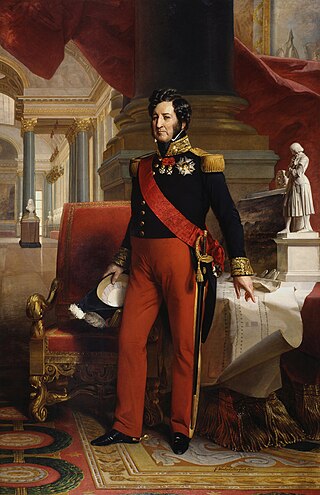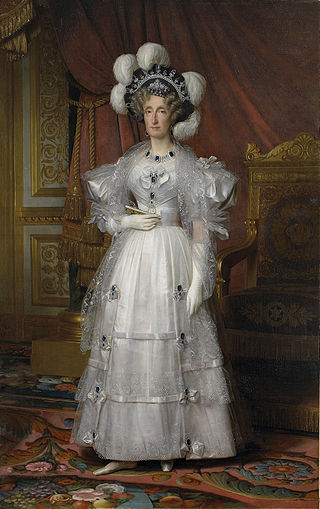
Marie-Henri Beyle, better known by his pen name Stendhal, was a French writer. Best known for the novels Le Rouge et le Noir and La Chartreuse de Parme, he is highly regarded for the acute analysis of his characters' psychology and considered one of the early and foremost practitioners of realism. A self-proclaimed egotist, the neologism for the same characteristic in his characters was "Beylism".

Louis Philippe I, nicknamed the Citizen King, was King of the French from 1830 to 1848, the penultimate monarch of France, and the last French monarch to bear the title "King." He abdicated from his throne during the French Revolution of 1848, which led to the foundation of the French Second Republic.

Abel-François Villemain was a French politician and writer.

Henri, Count of Chambord and Duke of Bordeaux, was the Legitimist pretender to the throne of France as Henri V from 1844 until his death in 1883.

Marie Joseph Louis Adolphe Thiers was a French statesman and historian who served as President of France from 1871 to 1873. He was the second elected president and the first of the Third French Republic.

Orléanist was a 19th-century French political label originally used by those who supported a constitutional monarchy expressed by the House of Orléans. Due to the radical political changes that occurred during that century in France, three different phases of Orléanism can be identified:

Philippe-Paul, comte de Ségur was a French general and a historian.

The French Revolution of 1830, also known as the July Revolution, Second French Revolution, or Trois Glorieuses, was a second French Revolution after the first in 1789. It led to the overthrow of King Charles X, the French Bourbon monarch, and the ascent of his cousin Louis Philippe, Duke of Orléans. After 18 precarious years on the throne, Louis-Philippe was overthrown in the French Revolution of 1848.

The July Monarchy, officially the Kingdom of France, was a liberal constitutional monarchy in France under Louis Philippe I, starting on 26 July 1830, with the revolutionary victory after the July Revolution of 1830, and ending 23 February 1848, with the Revolution of 1848. It marks the end of the Bourbon Restoration (1814–1830). It began with the overthrow of the conservative government of Charles X, the last king of the main line House of Bourbon.

Le Rouge et le Noir is a psychological novel in two volumes by Stendhal, published in 1830. It chronicles the attempts of a provincial young man to rise socially beyond his modest upbringing through a combination of talent, hard work, deception, and hypocrisy. He ultimately allows his passions to betray him.

Maria Amalia Teresa of Naples and Sicily was Queen of the French by marriage to Louis Philippe I, King of the French. She was the last queen of France.

Victor de Broglie, 3rd Duke of Broglie, briefly Victor de Broglie, was a French peer, statesman, and diplomat. He was the third duke of Broglie and served as president of the Council during the July Monarchy, from August 1830 to November 1830 and from March 1835 to February 1836. Victor de Broglie was close to the liberal Doctrinaires who opposed the ultra-royalists and were absorbed, under Louis-Philippe's rule, by the Orléanists.

The 4th House of Orléans, sometimes called the House of Bourbon-Orléans to distinguish it, is the fourth holder of a surname previously used by several branches of the Royal House of France, all descended in the legitimate male line from the dynasty's founder, Hugh Capet. The house was founded by Philippe I, Duke of Orléans, younger son of Louis XIII and younger brother of Louis XIV, the "Sun King".

Amable Guillaume Prosper Brugière, baron de Barante was a French statesman and historian. Associated with the center-left, he was described in France as the first man to call himself, "without any embarrassment or restriction, a Liberal."

Jean Maximilien Lamarque was a French general of the French Revolutionary Wars and the Napoleonic Wars who later became a member of the French Parliament. Lamarque served with distinction in many of Napoleon's campaigns. He was particularly noted for his capture of Capri from the British, and for his defeat of Royalist forces in the Vendée in 1815. The latter campaign received great praise from Napoleon, who said Lamarque had "performed wonders, and even surpassed my hopes".
Events from the year 1830 in France.

The French Revolution of 1848, also known as the February Revolution, was a period of civil unrest in France, in February 1848, that led to the collapse of the July Monarchy and the foundation of the French Second Republic. It sparked the wave of revolutions of 1848.
Le Rose et le Vert is an unfinished novel by Stendhal.

Souvenirs d’égotisme is an autobiographical work by Stendhal. It was written in 13 days in June and July 1832 while the author was staying in Civitavecchia. Stendhal recounts his life in Paris and London from 1821 to 1830. It includes candid and spirited descriptions of contemporaries such as Lafayette, Madame Pasta, Destutt de Tracy, Mérimée, and Charles de Rémusat. The story remained unfinished and was not published until 1892 by Casimir Stryienski.

The Life of Henry Brulard is an unfinished autobiography by Stendhal. It was begun on November 23, 1835, and abandoned March 26, 1836, while the author was serving as the French Consul in Civitavecchia. Stendhal had severe doubts about contemporary interest in his autobiography, so he bequeathed it to the reader of 1880, or of 1935, or 2000. The manuscript, including Stendhal's numerous diagrams and illustrations, was published in 1890. Stendhal primarily discusses his unhappy and dull childhood, touching briefly on his time as a soldier. The Life of Henry Brulard is considered a masterpiece of autobiographical writing and ironic self-reflection.

















